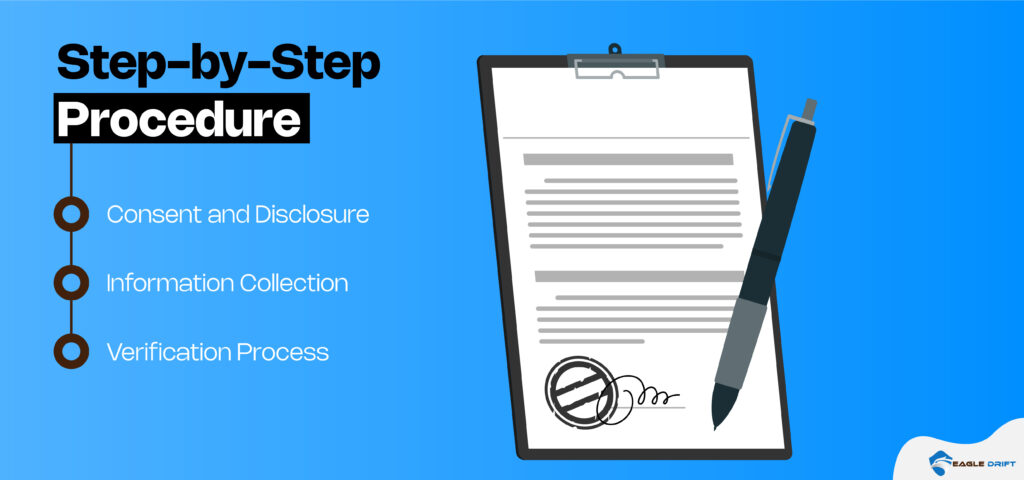

In the dynamic landscape of modern business, where trust is the currency that fuels success, organizations are turning to robust background check policies and procedures to safeguard their integrity. This article delves into the intricate world of background checks, exploring not only the necessity of such policies but also the meticulous steps involved in crafting and implementing them effectively.
As we navigate through the nuances of legal compliance, the significance of transparency, and the evolving landscape of industry-specific considerations, we aim to shed light on why a well-designed background check policy is not just a requirement but a strategic investment in building a secure and trustworthy organizational foundation.
Join us on this journey as we uncover the intricacies of Background Check Policy and Procedure, ensuring that organizations not only comply with legal standards but also foster an environment of trust and security for all stakeholders.
Understanding the Need for Background Checks
In the intricate realm of modern business practices, implementing comprehensive background checks has become a pivotal strategy for organizations aiming to establish trust and ensure legal compliance. This section delves into two fundamental aspects that underscore the need for background checks: the paramount importance of trust and the legal imperatives that guide organizations in this critical process.
The Importance of Trust
Trust is the cornerstone upon which successful organizations build lasting relationships with clients, partners, and employees. In this subsection, we explore how a well-executed background check policy fosters trust by demonstrating transparency and commitment to integrity.
Legal Compliance
Beyond the realm of trust, legal considerations play a pivotal role in shaping background check policies. This subsection examines the legal landscape surrounding background checks, emphasizing organizations’ need to navigate this terrain with precision to ensure compliance with relevant laws and regulations.
Crafting an Effective Background Check Policy
Crafting a background check policy requires careful consideration and precision to ensure its effectiveness. This section delves into the crucial elements of this process, focusing on defining the scope and purpose of the policy and navigating the intricate landscape of legal considerations.
Defining Scope and Purpose
Before embarking on the detailed procedures, organizations must clearly define the scope and purpose of their background check policy. This involves specifying the positions within the organization that necessitate screening and establishing the overarching objectives behind each background check. This subsection explores the foundational steps that set the stage for a comprehensive and targeted policy.
Legal Considerations
Navigating the legal landscape is paramount to crafting a background check policy. This subsection addresses the intricate legal considerations that organizations must take into account. From obtaining informed consent to complying with privacy laws, understanding and incorporating legal requirements are essential for successfully implementing an effective background check policy.
Step-by-Step Procedure

Once the foundation of a background check policy is laid, the next crucial phase involves the step-by-step procedures followed in the screening process. This section outlines the detailed sequence, emphasizing three key components: obtaining consent and disclosure, collecting relevant information, and executing the verification process.
Consent and Disclosure
Initiating a background check begins with obtaining explicit consent from the individual under scrutiny. This subsection explores the importance of transparency and the need to disclose the nature and scope of the check. Understanding how to navigate this initial step ensures that the process starts on a foundation of openness and informed agreement.
Information Collection
With consent secured, the policy moves into gathering pertinent information. This subsection details the information collection process from educational credentials to employment history. A comprehensive approach to collecting data is vital for a thorough evaluation, ensuring that the organization obtains accurate and relevant information.
Verification Process
At the heart of the background check lies the verification process. This subsection delves into the methods and tools employed to verify the accuracy of the information collected. From contacting previous employers to validating educational credentials, a robust verification process is crucial for substantiating the authenticity of the candidate’s background.
Ensuring Fairness and Non-Discrimination
While conducting background checks is essential, ensuring fairness and guard against discrimination throughout the process is equally crucial. This section focuses on two key aspects: addressing bias in the evaluation and establishing guidelines for handling information related to criminal records.
Addressing Bias
Guarding against bias is paramount in maintaining a fair and inclusive background check policy. This subsection explores strategies and best practices to minimize biases that may inadvertently influence the evaluation process. Organizations can ensure that every candidate is treated equitably by promoting objectivity and fairness.
Handling Criminal Records
Dealing with information about criminal records requires a delicate and legally compliant approach. This subsection delves into the nuanced considerations involved in handling such sensitive information. It highlights the importance of adhering to legal regulations, ensuring fairness, and striking a balance between assessing potential risks and respecting the rights of the individual under scrutiny.
Employee Communication and Transparency
In background checks, effective communication and transparency with employees play a pivotal role in fostering trust and understanding. This section focuses on two vital components: educating employees about the background check process and establishing open communication channels to address their concerns.
Educating Employees
Transparent communication starts with educating employees about the purpose and procedures of background checks. This subsection explores the importance of providing clear information to employees, dispelling myths, and helping them understand the significance of the process. By fostering awareness, organizations create an environment where employees can appreciate the necessity and fairness of background checks.
Open Communication Channels
Establishing open lines of communication is essential for building trust and addressing any apprehensions employees may have regarding background checks. This subsection delves into organizations’ strategies to create an atmosphere where employees feel comfortable discussing their concerns or seeking clarification. Open communication fosters a positive workplace culture, reinforcing the organization’s commitment to transparency and fairness.
Choosing the Right Background Check Provider
Selecting the appropriate background check provider is critical for organizations seeking to implement an effective screening process. This section outlines two key considerations: conducting thorough research and due diligence and performing a comprehensive cost-benefit analysis.
Research and Due Diligence
Navigating the landscape of background check providers requires diligent research. This subsection guides employers through the process of researching potential providers. It highlights the importance of assessing factors such as reputation, industry experience, and the range of services offered. By conducting due diligence, organizations can make informed decisions aligning with their needs.
Cost-Benefit Analysis
While cost is undeniably a consideration, this subsection emphasizes the need for a holistic perspective through a cost-benefit analysis. It explores the various elements that contribute to the overall value provided by a background check provider. By evaluating the benefits against the costs, organizations can ensure that their investment yields the desired outcomes and aligns with the overarching goals of the screening process.
Periodic Review and Updates
Maintaining the effectiveness of a background check policy requires a commitment to ongoing review and adaptation. This section explores two key aspects: adapting to legal changes and staying current with best practices.
Adapting to Legal Changes
The legal landscape surrounding background checks is dynamic and subject to frequent changes. This subsection underscores the importance of periodic reviews to ensure the policy remains aligned with the latest legal requirements. By staying vigilant and adapting swiftly to legal changes, organizations safeguard themselves against potential risks and liabilities.
Staying Current with Best Practices
Beyond legal considerations, staying abreast of industry best practices is essential for a background check policy’s continued relevance and effectiveness. This subsection delves into the benefits of embracing innovation and adopting evolving industry standards. By incorporating best practices, organizations enhance the efficiency of their policies and contribute to the overall trustworthiness of their screening processes.
Challenges and Pitfalls to Avoid
In the intricate landscape of background checks, organizations must be mindful of potential challenges and pitfalls. This section delves into two critical considerations: addressing privacy concerns and mitigating the risks associated with inaccurate information.
Privacy Concerns
Privacy stands as a paramount concern in the realm of background checks. This subsection explores strategies to address and alleviate privacy concerns, ensuring that the sensitive information gathered during the screening process is handled with the utmost care and compliance with relevant privacy regulations.
Inaccurate Information
The repercussions of false positives and inaccuracies in background checks can be severe, potentially damaging reputations and undermining the integrity of the screening process. This part outlines measures to minimize inaccuracies, emphasizing the importance of thorough verification processes and data validation. By implementing these measures, organizations can enhance the accuracy of background checks, contributing to fair and reliable evaluations.
Benefits of a Robust Background Check Policy
A well-implemented background check policy extends beyond compliance; it serves as a cornerstone for organizational success. This section explores two key benefits: building a trustworthy workforce and mitigating potential risks.
Building a Trustworthy Workforce
Trust is the foundation of any successful organization, and a robust background check policy plays a pivotal role in establishing and maintaining that trust. This subsection delves into how a thorough screening process builds a workforce that exudes credibility and reliability. Employers foster an environment where trust flourishes among team members and stakeholders by ensuring that individuals within the organization meet the required standards.
Mitigating Risks
In the complex landscape of modern business, risks are inherent. A well-crafted background check policy is a proactive measure to identify and mitigate these risks. This part explores how a comprehensive screening process can uncover potential issues, from legal concerns to workplace conflicts. Organizations can take preventive measures by addressing these risks early on, fostering a secure and resilient operational environment.
Measuring the Effectiveness of Your Policy
Ensuring a background check policy’s ongoing success necessitates a systematic evaluation and improvement approach. This section focuses on two crucial aspects: identifying key performance indicators (KPIs) and emphasizing the significance of continuous improvement.
Key Performance Indicators
Measuring the impact of a background check policy requires a set of well-defined key performance indicators (KPIs). This subsection outlines the essential metrics that organizations should track to gauge the effectiveness of their policies. Organizations can obtain valuable data insights by employing these KPIs, enabling informed decision-making and targeted improvements.
Continuous Improvement
Effectiveness is not a static achievement but an evolving goal. This part underscores the importance of continuous improvement in the context of background check policies. Organizations are encouraged to adapt their policies to meet evolving organizational needs and industry trends. By fostering a culture of continuous improvement, organizations ensure that their background check policies remain effective and aligned with the dynamic nature of the business landscape.
Industry-Specific Considerations

Recognizing the diverse nature of industries, it’s crucial to tailor background check policies to address specific sector requirements. This section explores two distinct industries, healthcare and finance, shedding light on each demand’s unique considerations.
Healthcare
In the healthcare sector, stringent requirements and patient safety concerns necessitate a specialized approach to background checks. This subsection delves into the unique considerations for healthcare background check policies. From ensuring the qualifications of medical professionals to addressing regulatory compliance, organizations in this field must navigate a distinct set of challenges to maintain the highest standards of patient care and safety.
Finance
The financial sector operates in a high-stakes environment where trust and credibility are paramount. This part examines the nuances of background checks in finance, emphasizing their critical role in maintaining financial institutions’ integrity. From assessing the financial responsibility of employees to safeguarding against fraudulent activities, background check policies in finance are tailored to address the specific demands of this industry, ensuring a secure and trustworthy financial landscape.
Common Misconceptions About Background Checks
Dispelling myths and clarifying misconceptions is essential for fostering a clear understanding of background check processes. This section addresses two prevalent misconceptions:
All Background Checks Are the Same
Contrary to popular belief, not all background checks are created equal. This subsection examines the misconception that background checks follow a one-size-fits-all approach. By highlighting the diverse nature of background checks, tailored to each organization’s specific needs and requirements, readers gain a nuanced understanding of the variations in screening processes.
Background Checks Are Invasive
Addressing concerns about invasiveness, this part emphasizes the importance of balancing gathering the necessary information and respecting individuals’ privacy. By exploring the safeguards and ethical considerations embedded in background check policies, this subsection dispels the misconception that background checks are inherently invasive, showcasing the commitment to fairness and transparency in the screening process.
Conclusion
In conclusion, a well-crafted background check policy is not merely a compliance requirement but a strategic investment in building trust, credibility, and a secure organizational foundation. This comprehensive exploration has navigated the intricacies of establishing such policies, from understanding the fundamental need for background checks to the industry-specific considerations shaping their implementation.
By delving into the step-by-step procedures, ensuring fairness, and emphasizing transparent communication with employees, organizations lay the groundwork for a screening process that meets legal standards and contributes to a positive workplace culture.
Selecting the right background check provider, periodic reviews, and continuous improvement are pivotal in adapting to the dynamic landscape of legal changes and industry best practices. Furthermore, the benefits of a robust background check policy extend to building a trustworthy workforce, mitigating risks, and contributing to organizational resilience.
Real-life examples and case studies provide tangible evidence of success, while lessons learned from challenges underscore the importance of flexibility and adaptability in policy implementation.
Measuring the effectiveness of a background check policy through key performance indicators and committing to continuous improvement ensures its ongoing relevance and alignment with organizational goals.
Lastly, industry-specific considerations acknowledge the unique needs of sectors like healthcare and finance, demonstrating the adaptability of background check policies to diverse professional landscapes.
FAQs
How often should background check policies be reviewed?
At least annually, regular reviews are recommended to ensure alignment with legal changes and industry best practices. Keeping policies up-to-date is crucial for maintaining effectiveness.
Can a background check policy be too stringent?
While thoroughness is essential, policies should strike a balance to avoid unnecessary invasion of privacy. It’s critical to tailor the stringency of policies to align with the specific needs and nature of the organization.
What industries benefit most from robust background check policies?
Industries dealing with sensitive information, such as finance and healthcare, benefit significantly from robust background check policies. However, the level of scrutiny may vary based on the unique requirements of each sector.
How can organizations address concerns about discrimination in background checks?
Implementing bias-mitigating strategies and providing clear communication are key. Organizations should ensure that their background check processes are fair, transparent, and free from discriminatory practices.
Are there alternatives to traditional background checks?
Depending on the industry, alternative methods, such as skills assessments or character references, can complement traditional background checks. Organizations should explore options that align with their specific needs and industry standards.


